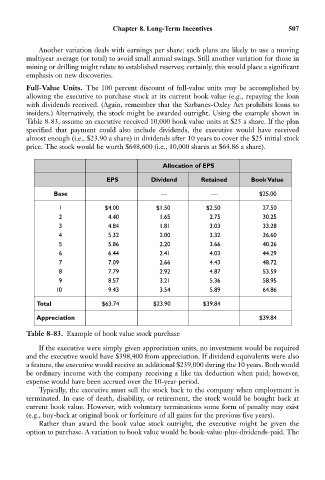Page 521 - Bruce Ellig - The Complete Guide to Executive Compensation (2007)
P. 521
Chapter 8. Long-Term Incentives 507
Another variation deals with earnings per share; such plans are likely to use a moving
multiyear average (or total) to avoid small annual swings. Still another variation for those in
mining or drilling might relate to established reserves; certainly, this would place a significant
emphasis on new discoveries.
Full-Value Units. The 100 percent discount of full-value units may be accomplished by
allowing the executive to purchase stock at its current book value (e.g., repaying the loan
with dividends received. (Again, remember that the Sarbanes-Oxley Act prohibits loans to
insiders.) Alternatively, the stock might be awarded outright. Using the example shown in
Table 8-83, assume an executive received 10,000 book value units at $25 a share. If the plan
specified that payment could also include dividends, the executive would have received
almost enough (i.e., $23.90 a share) in dividends after 10 years to cover the $25 initial stock
price. The stock would be worth $648,600 (i.e., 10,000 shares at $64.86 a share).
Allocation of EPS
EPS Dividend Retained Book Value
Base — — $25.00
1 $4.00 $1.50 $2.50 27.50
2 4.40 1.65 2.75 30.25
3 4.84 1.81 3.03 33.28
4 5.32 2.00 3.32 36.60
5 5.86 2.20 3.66 40.26
6 6.44 2.41 4.03 44.29
7 7.09 2.66 4.43 48.72
8 7.79 2.92 4.87 53.59
9 8.57 3.21 5.36 58.95
10 9.43 3.54 5.89 64.86
Total $63.74 $23.90 $39.84
Appreciation $39.84
Table 8-83. Example of book value stock purchase
If the executive were simply given appreciation units, no investment would be required
and the executive would have $398,400 from appreciation. If dividend equivalents were also
a feature, the executive would receive an additional $239,000 during the 10 years. Both would
be ordinary income with the company receiving a like tax deduction when paid; however,
expense would have been accrued over the 10-year period.
Typically, the executive must sell the stock back to the company when employment is
terminated. In case of death, disability, or retirement, the stock would be bought back at
current book value. However, with voluntary terminations some form of penalty may exist
(e.g., buy-back at original book or forfeiture of all gains for the previous five years).
Rather than award the book value stock outright, the executive might be given the
option to purchase. A variation to book value would be book-value-plus-dividends-paid. The

